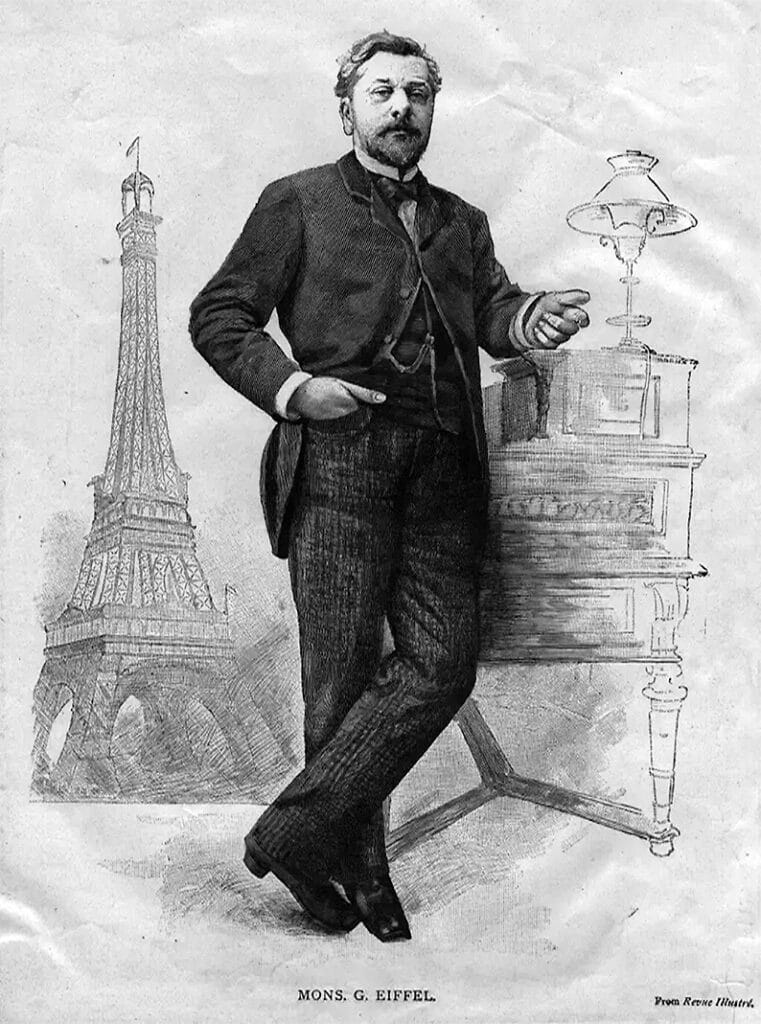“Being the most striking manifestation of the art of metal structures by which our engineers have shown in Europe, it is one of the most striking of our modern national genius.”
– Gustave Eiffel

Victor Lustig was an incredibly charming man. The book ‘Handsome Devil’ by Jeff Maysh is based on his life. A precocious young boy who grew into a highly intelligent man, fluent in five languages, university-educated, very well spoken and extremely well dressed; he was likeable – and all of the above allowed him to integrate well amongst many different groups of people, most notably wealthy people. It was this likeability that garnered him the trust of high-ranking officials and wealthy people within his circles; they trusted him, which in turn meant he could con them. Every conversation, every meeting, every twist and every turn was a confidence trick to lure his mark. His brilliance in conning people eventually led him to selling the Eiffel Tower! Not just once, but twice.
Lustig was born in Hostinné, Bohemia, Austria-Hungary, which is today known as the Czech Republic. He became infatuated with money. He wanted to get it, he wanted it to appear that he had it and he wanted to give the impression he came from it, which is why he dubbed himself the ‘Count’, a title with which he concocted a background story. Lustig told people he came from Austrian-Hungarian royalty – again another confidence trick. He used this self-imposed moniker to great success with his first of many cons.
The Rumanian Box was Victor ‘Count’ Lustig’s first venture into con artistry. Lustig claimed this relatively small mahogany box could ‘print’ money and he brought one with him wherever he travelled. Exceptionally well made and beautiful, decorated with gold hinges and other ornamental details; on the outside the box was made of varnished mahogany, solid except for two slots, similar to the slot at an ATM today where you collect your money. One was an entry slot where a blank sheet of paper was placed. The other was an exit slot that ‘printed’ a $100 bill. Lustig presented his machine to wealthy people he had befriended. However, he did this discreetly, as if he was sharing a secret, and never to a large group. Lustig never tried to sell the machine. He simply displayed it to his ‘friend’, waiting until the friend made an enquiry as to how he or she might acquire one – then he would sell. The trick worked on the basis that the box already contained several genuine $100 dollar bills. Therefore you put in a blank sheet the same dimensions as a $100 bill and the machine would return a genuine bill. Lustig said it took six hours for the machine to create the money. They inserted the blank sheet together and he waited the six hours with the mark until the machine ‘printed’ the money. After any last-minute suspicions were allayed through successful test runs, Lustig then took the mark to a bank of their choosing to have the note verified. He sold these machines for between $10,000 and up to $30,000 in some cases. He’d fill the box with a few genuine bills, sell the machine, and then disappear. The mark would print several real bills over the course of the next 18 to 24 hours before the box stopped working and they realised it was a scam. By which time Lustig was in a different country!
After fleeing one such sale, Lustig found himself in Paris, where he concocted possibly the greatest con of all time and the one he is most famous for performing: The sale of the Eiffel Tower…and not once, but twice.
While reading a newspaper article about how difficult it was to maintain the Eiffel Tower in post war France due to a lack of available funds, Lustig saw an opening for the Eiffel Tower con. His best one yet. At the time, the monument had begun to fall into disrepair and the city was finding it increasingly expensive to maintain and repaint it. Part of the article made a passing comment that overall public opinion on the monument would move towards calls for its removal, which was key to convincing Lustig that using it as part of his next con would be lucrative. It is important to note that the Eiffel Tower was initially erected in 1889 as the entrance to the Exposition Universelle or the World’s Fair. The tenth Exposition Universelle was organised in Paris in 1889, from May to November 6. It was never meant to be a permanent landmark and, at first, it was hated; even causing regret for the people involved in its creation, as they felt it tarnished their legacy and the beauty of France.
After researching what he needed, to help him utilise the information from the article, Lustig set to work preparing the scam, which included hiring a forger to produce fake government stationery for him. He sent out letters on fake stationery, claiming to be the ‘Deputy Director of the Ministere de Postes et Telegraphes’ and requesting meetings that, he told them, might prove lucrative. In exchange for such meetings, he demanded absolute discretion. He took a room at the Hotel de Crillon, one of the city’s most upscale hotels. Lustig rented limousines and gave tours of the tower, all to discern, which dealer would make the ideal mark.
Lustig wined and dined his marks, giving a presentation on the topic. He announced that the government had decided to tear down the Eiffel Tower, and the resulting 7000 tons of metal would be for sale to the highest bidder among them. As part of his pitch, he reminded his guests that the Tower was built as an entrance arch to the 1889 World’s Fair and was never meant to be permanent. He quoted Alexander Dumas, who had once called the Tower “a loathsome construction”, and writer Guy de Maupassant, who said, “What will be thought of our generation if we do not smash this lanky pyramid”. Lustig gave an emotional performance and then, in a resigned tone, explained that the costs to maintain the Tower were simply too high. Of course, the government’s decision to tear it down was controversial and the information must at all times be kept in the strictest confidence.
A few days later his ‘marks’ submitted their bids. But Lustig had already chosen his mark. André Poisson, a scrap metal merchant who owned his own business, was fairly new to the city, which is why Lustig quickly decided to focus on him. Lustig told Poisson that, as a public official, he didn’t earn much money and finding a buyer for the Eiffel Tower was a very big decision. Lustig informed Poisson that he would give him the right to the Eiffel Tower’s metal. But there was a small problem. Lustig said that while public servants like himself were expected to dress well and entertain lavishly, they made a meagre salary. Poisson had been in Paris long enough to know what Lustig was getting at. He was being asked for a bribe to secure the deal, and he obliged. Poisson would pay Lustig $20,000 in cash, plus an additional $50,000 if Lustig could see to it that his was the winning bid. Lustig secured the $70,000 and, in less than an hour, he was on his way back to Austria. He waited for the story to break, with, possibly, a description and sketch of himself, but it never did. Poisson, fearful of the embarrassment such a disclosure would bring upon him, chose not to report Lustig’s scam.
Lustig suspected that when Poisson found out he had been conned, he would be too ashamed and embarrassed to inform the French police of what he had been caught up in, yet despite this belief, he maintained a check on newspapers while in Austria. His suspicions soon proved to be correct when he could find no reference of his con within their pages. Thus he decided to return to Paris later that year to pull off the scheme once more. However, ever cautious, the Count came to suspect that one of the new scrap dealers he contacted had notified the police, so he fled to the United States.
When the Great Depression hit, Lustig concocted a risky scam aimed at Al Capone. For Lustig, the scam was not a straight-out con, but again another confidence trick. Lustig asked Capone to invest $50,000 in business and then kept the money given to him in a safe deposit box for two months before returning it, claiming the fictitious deal had fallen through. Capone got the impression that he was dealing with an honest man. At this point, Lustig told Capone that the failure of the deal meant he had lost all means of supporting himself. He then convinced Capone to give him $5,000 so that he would have the means to support himself until another possible business opportunity arose. He took the money and again disappeared.
Victor Lustig then entered the counterfeiting business. Teaming up with gangland forger William Watts, Lustig created banknotes so flawless they fooled even bank tellers. “Lustig-Watts notes were the super notes of the era,” says Joseph Boling, chief judge of the American Numismatic Association, a specialist in authenticating notes. Lustig daringly chose to copy $100 bills, those scrutinised most by bank tellers, and became “like some other government, issuing money in rivalry with the United States Treasury,” a judge later commented. It was feared that a run of fake bills this large could wobble international confidence in the dollar. The fake money became known as ‘Lustig’ Money and millions of dollars was produced. They were so successful that the US economy feared that the amount of ‘Lustig’ money in the economy would start to interfere with inflation rates. Eventually, a scorned close associate informed on Lustig and he went on the run. Remaining on the run for many years, he was eventually arrested on May 10, 1935.
At the time of his arrest, Lustig was wearing a beautiful coat with a velvet collar and was carrying a suitcase full of expensive clothes. On searching him, police officers found a key in his wallet. Lustig would not give any information as to what the key opened. After some time, the police traced to key to a bank deposit box. Inside was $51,000 in counterfeit notes and the plates used to forge the notes. Lustig was sentenced to 25 years in Alcatraz. In the course of his ‘career’, he used 47 aliases and carried dozens of fake passports. The name Robert V. Miller is the pseudonym used on his Alcatraz paperwork.
Lustig died of pneumonia on March 11, 1947. On his death certificate, ‘apprentice salesman’ was written as his occupation.



